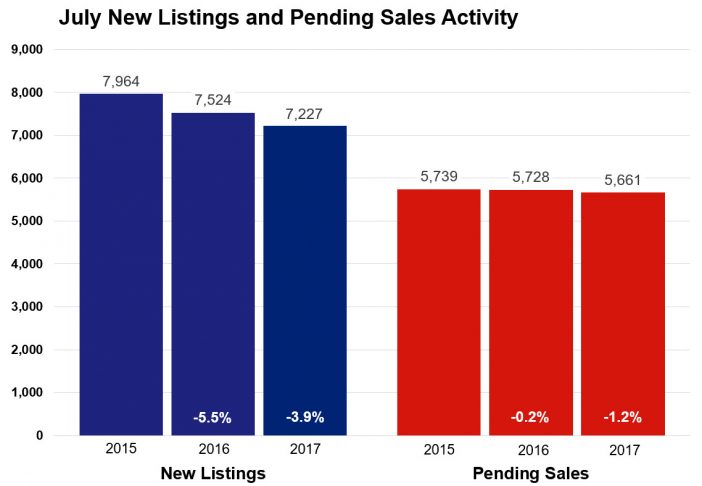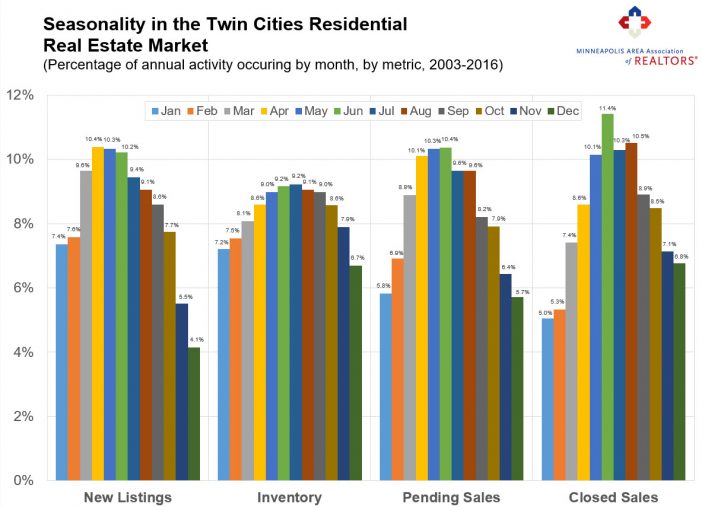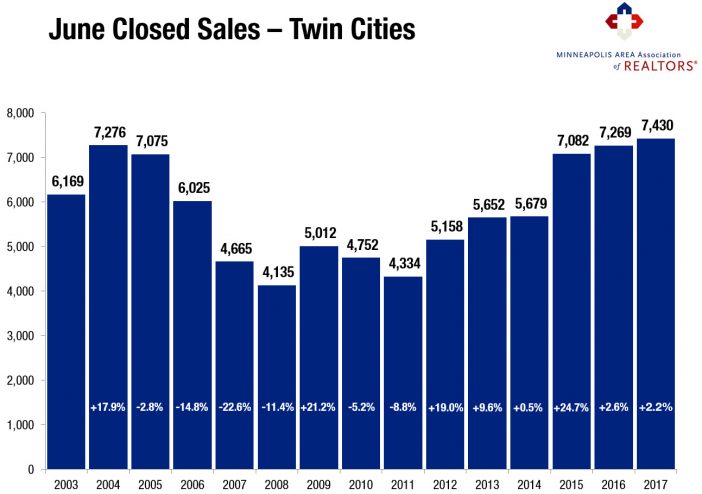Author Archives: admin
Weekly Market Report

For Week Ending August 12, 2017
The prevailing trends have continued to prevail through the summer, which has not really been a surprise. There have not been any jolting changes in the economy that would affect residential real estate. This includes steady news for factors such as wage growth, unemployment, new construction and mortgage rates. Every locality has its unique challenges, but housing as a whole is performing as expected.
In the Twin Cities region, for the week ending August 12:
- New Listings increased 1.2% to 1,668
- Pending Sales decreased 8.0% to 1,195
- Inventory decreased 17.1% to 12,576
For the month of July:
- Median Sales Price increased 5.9% to $254,000
- Days on Market decreased 16.7% to 45
- Percent of Original List Price Received increased 0.8% to 99.2%
- Months Supply of Inventory decreased 19.4% to 2.5
All comparisons are to 2016
Click here for the full Weekly Market Activity Report. From The Skinny Blog.
Pricing strong, but shortage continues to hold back market activity
While June 2017 marked an all-time home sales record for the Twin Cities, closed sales retreated slightly in July compared to 2016. A slow-down in sellers listing their homes was a contributing factor, as was low inventory. New listings decreased 3.9 percent from last year to 7,227, and the number of homes for sale decreased 18.3 percent to 12,407. That was the largest inventory decline in five months. Pending sales declined 1.2 percent to 5,661, and closed sales were down 2.6 percent to 6,020. Factoring out foreclosures and short sales, traditional pending sales increased 0.7 percent to 5,484.
Weak supply and robust demand tend to encourage rising prices. The median sales price rose 5.9 percent from last year to $254,000—a new monthly record for July. Home prices have now risen for the last 65 consecutive months. At 44 days on average, homes went under contract 18.5 percent faster than last July. Despite there being fewer of them, sellers who have listed their homes recently are receiving strong offers in less time. The average percent of original list price received at sale was 99.2 percent, 0.8 percent higher than July 2016. The metro area has just 2.5 months of housing supply. Generally, five to six months of supply is considered a balanced market where neither buyers nor sellers have a clear advantage.
“The market is always adjusting to changing conditions,” said Cotty Lowry, Minneapolis Area Association of REALTORS® (MAAR) President, “Although we saw a nice gain in new construction listings in July, that segment is typically a few years behind and is a drop in the bucket compared to the existing resale market where sellers have felt stuck with nowhere to go.”

Not only is the move-up market less competitive than the entry-level price points, but move-up sellers are getting strong offers on their homes in record time. Because of the fast pace of the market and lack of inventory, it’s extremely rare for sellers to carry two mortgages for more than a month.
A thriving and diverse local economy has been conducive to housing recovery, as job growth is key to new household formations. The most recent national unemployment rate is 4.3 percent, though it’s 3.5 percent locally. The Minneapolis–St. Paul region has a resilient economy with a global reach, a talented workforce, top notch schools, exposure to the growing technology and healthcare fields, and a quality of life that’s enabled one of the highest homeownership rates in the country.
The average 30-year fixed mortgage rate has declined from 4.3 percent to 3.9 percent recently, still well below its long-term average of around 8.0 percent. Excluding any surprising data or events, the Federal Reserve is likely to increase their target federal funds rate at least once more this year. Additional inventory is needed in order to offset declining affordability brought on by higher prices and interest rates.
“The fact that buyers are hardly phased by the lack of inventory speaks to the appeal of homeownership and of our region,” said Kath Hammerseng, MAAR President-Elect. “The current environment calls for additional patience, persistence and compromise, but Minnesotans are known for those traits.”
All information is according to the Minneapolis Area Association of REALTORS® (MAAR) based on data from NorthstarMLS. MAAR is the leading regional advocate and provider of information services and research on the real estate industry for brokers, real estate professionals and the public. MAAR serves the Twin Cities 13-county metro area and western Wisconsin.
From The Skinny Blog.
Weekly Market Report

For Week Ending August 5, 2017
As we reach into August, we’ll begin to see the volume of activity wane in anticipation of the school year. Although not every buyer or seller has children, it’s no secret that homeownership is a popular housing option for those with kids. In bulk, this has historically been enough of a factor for turning down the summer’s market heat before lower temperatures take hold.
In the Twin Cities region, for the week ending August 5:
- New Listings decreased 0.5% to 1,787
- Pending Sales decreased 3.6% to 1,285
- Inventory decreased 16.9% to 12,541
For the month of June:
- Median Sales Price increased 7.0% to $259,000
- Days on Market decreased 16.1% to 47
- Percent of Original List Price Received increased 0.8% to 99.5%
- Months Supply of Inventory decreased 13.3% to 2.6
All comparisons are to 2016
Click here for the full Weekly Market Activity Report. From The Skinny Blog.
Weekly Market Report

For Week Ending July 29, 2017
A favorable economy has kept buyers active amidst a summer of stiff competition that has led prices upward and often over the asking price. The latest recorded national unemployment rate of 4.3 is historically low and has served as a general indicator of a strong economy. If wage growth shifts into overdrive from its current state of patient increases, we may see even higher prices or, conversely, more willingness by sellers to increase the inventory pool.
In the Twin Cities region, for the week ending July 29:
- New Listings decreased 2.3% to 1,686
- Pending Sales decreased 4.7% to 1,300
- Inventory decreased 16.9% to 12,645
For the month of June:
- Median Sales Price increased 7.0% to $259,000
- Days on Market decreased 16.1% to 47
- Percent of Original List Price Received increased 0.8% to 99.5%
- Months Supply of Inventory decreased 13.3% to 2.6
All comparisons are to 2016
Click here for the full Weekly Market Activity Report. From The Skinny Blog.
Seasonal Adjustments
Given the fact that the school year is about a month away (yikes) and we’ve already had our first preview of fall weather, it feels like a good time to talk about seasonality. First of all, whatever you do, don’t use the term “seasonably adjusted.” Second of all, don’t make matters worse by talking about the “seasonably adjusted medium sales price.” That’s not a thing.
All kidding aside, both agents and the public have a vested interested in knowing how and when listings, inventory levels, purchase agreements and closed sales ebb and flow throughout the year. Ever been asked the question or wondered “when do the most new listings come on the market?” Or “when do buyers write the most offers?” Or how about “what month tends to have the greatest number of homes for sale?”
These are legitimate and important questions that can inform a variety of market-related strategies. Technically, April sees the highest volume of new listings, but buyers have the greatest number of choices in July. Signed purchase agreements peak in June along with closed sales. The shape of the seasonal curves can also be revealing. Seller activity tends to ramp up quickly in March and April and then quiet down rapidly starting in October. New listings are front-loaded in the first half of the year. Buyer activity, particularly pending sales, tends to follow more of a “normal” or even distribution throughout the year.

From The Skinny Blog.
Weekly Market Report

For Week Ending July 22, 2017
Residential real estate activity has remained robust through the summer months so far. New listing and sales activity may not always land exactly where desired or expected from week to week, but it is clear by gradually increasing prices and ongoing low inventory that buyer demand has not weakened.
In the Twin Cities region, for the week ending July 22:
- New Listings increased 0.9% to 1,842
- Pending Sales decreased 6.3% to 1,297
- Inventory decreased 17.2% to 12,555
For the month of June:
- Median Sales Price increased 7.0% to $259,000
- Days on Market decreased 16.1% to 47
- Percent of Original List Price Received increased 0.8% to 99.5%
- Months Supply of Inventory decreased 13.3% to 2.6
All comparisons are to 2016
Click here for the full Weekly Market Activity Report. From The Skinny Blog.
Weekly Market Report

For Week Ending July 15, 2017
The primary selling season tends to begin a subtle slowdown at this point in the year. That does not necessarily equate to less competition for available housing stock. While total sales and inventory may be lower than at points earlier in the year, those still looking for homes tend to match up with those willing to list. Call it a back-to-school effect or call it an active and healthy residential real estate market no matter the season.
In the Twin Cities region, for the week ending July 15:
- New Listings increased 2.2% to 1,936
- Pending Sales decreased 3.9% to 1,371
- Inventory decreased 17.7% to 12,362
For the month of June:
- Median Sales Price increased 7.0% to $259,000
- Days on Market decreased 16.1% to 47
- Percent of Original List Price Received increased 0.8% to 99.5%
- Months Supply of Inventory decreased 16.7% to 2.5
All comparisons are to 2016
Click here for the full Weekly Market Activity Report. From The Skinny Blog.
Sales and prices hit new highs, despite inventory constraints
Despite the decelerating gains in buyer activity, June 2017 was a new record high for home sales in the Twin Cities. Compared to last June, closed sales in the metro rose 2.2 percent to reach a new high of 7,430 units. Meanwhile, pending sales only showed a 0.2 percent gain and new listings fell 0.5 percent. Persistently low inventory levels are keeping some would-be buyers out of the market. The number of homes for sale fell 16.5 percent to 12,464 active listings in the metro. Declining foreclosure and short sale activity can contribute to market-wide declines. For example, within the traditional segment, new listings rose 1.6 percent and pending sales rose 2.4 percent.
Prices are still marching higher. In fact, the median sales price rose 7.0 percent from last year to $259,000—a new record high. Home prices have now risen for the last 64 consecutive months. At 47 days on average, homes went under contract 16.1 percent faster than last June. However, half the homes that went under contract in June took less than 20 days to do so. The average percent of original list price received at sale was 99.5 percent, 0.8 percent higher than June 2016. Similarly, the median percent of original list price received at sale was 100.0 percent, meaning half the sales closed for over list price. The metro area has a sparse 2.5 months of housing supply—the lowest June reading since 2003. Generally, five to six months of supply is considered a balanced market where neither side has a clear advantage.
“The numbers confirm what agents already know about this market,” said Cotty Lowry, Minneapolis Area Association of REALTORS® (MAAR) President, “We are still very thirsty for listings. That means sellers who list well-presented, well-priced homes are being rewarded, and they’re finding the move-up market to be less competitive.”

A thriving and diverse local economy has been conducive to housing recovery, as job growth is key to new household formations. The most recent national unemployment rate is 4.4 percent, though it’s 3.7 percent locally. The Minneapolis–St. Paul region has a resilient economy with a global reach, a talented workforce, top notch schools and a quality of life that’s enabled one of the highest homeownership rates in the country.
The average 30-year fixed mortgage rate has declined from 4.3 percent to 4.0 percent recently, still well below its long-term average of about 8.0 percent. Excluding any surprising data or events, the Federal Reserve is likely to increase their target federal funds rate at least once more this year. Wage and inventory growth are key to offsetting affordability declines brought on by higher rates and rising prices.
“Although supply is tight, attractive and competitively-priced homes remain in high demand,” said Kath Hammerseng, MAAR President-Elect. “But even as construction activity recovers somewhat, wage and housing supply growth remain key to balancing out affordability concerns.”
From The Skinny Blog.
Weekly Market Report

For Week Ending July 8, 2017
From a heart-of-summer perspective, the residential real estate market has performed as expected when predictions were made at the front of the year. Buyer interest is high and inventory is not at a proper level to meet demand. Total sales and new listings are generally behind last year’s levels from week to week, but there is evidence of improvement in both metrics.
In the Twin Cities region, for the week ending July 8:
- New Listings decreased 16.9% to 1,371
- Pending Sales decreased 4.7% to 1,061
- Inventory decreased 16.7% to 12,351
For the month of June:
- Median Sales Price increased 7.0% to $259,000
- Days on Market decreased 16.1% to 47
- Percent of Original List Price Received increased 0.8% to 99.5%
- Months Supply of Inventory decreased 16.7% to 2.5
All comparisons are to 2016
Click here for the full Weekly Market Activity Report. From The Skinny Blog.
